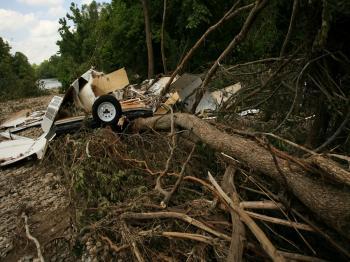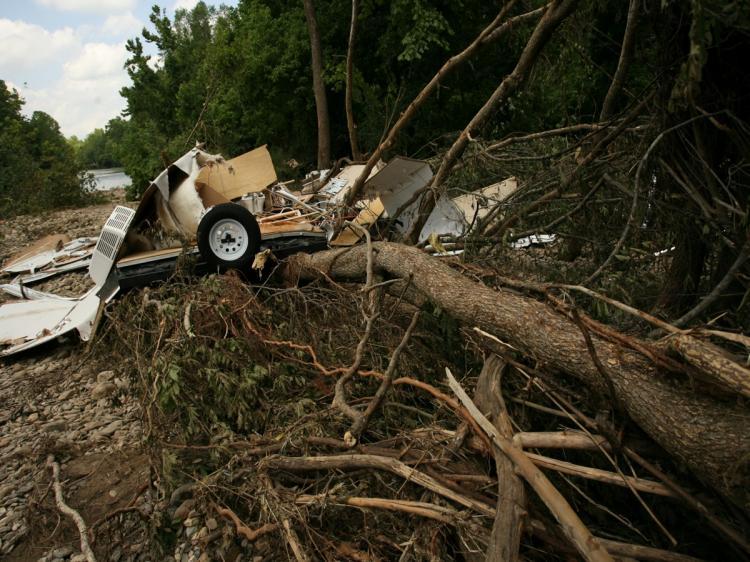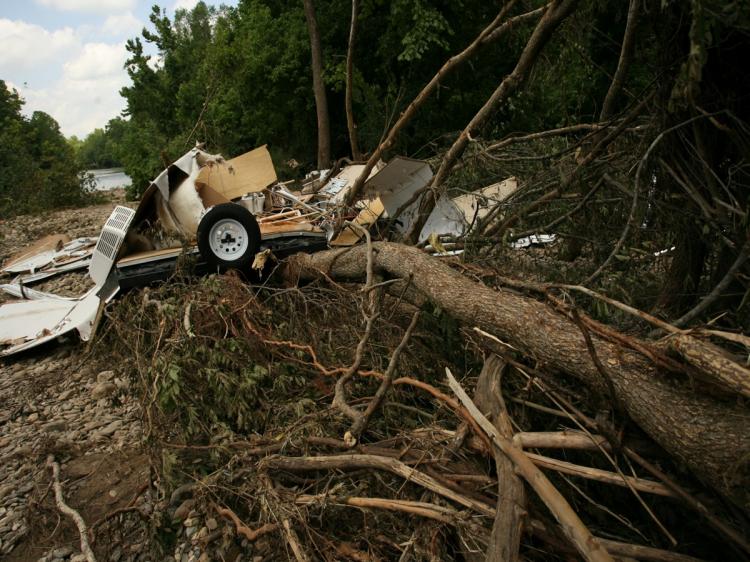Flash floods are the number one cause of human weather-related death in the U.S. and nearly half these fatalities occur in automobiles. This research is from the United States Geological Survey (USGS) and the National Oceanic and Atmospheric Administration (NOAA).
Flash floods come on fast and unexpectedly. During the flash flood last week on the Little Missouri River in Southwest Arkansas, the water rose over 20 feet in five hours. Twenty people sleeping on the banks died. The torrent ripped up asphalt and lifted cars.
“‘Be prepared’ is the name of the game,” said Dr. Robert Holmes, national flood specialist with the USGS. Holmes was part of a team of scientists who went to Arkansas to study the flood site.
“Be cautious and conservative in picking your location where you’re going to camp,” he said in a telephone interview.
Holmes said campers should look at nearby water channels and notice the slope of the banks; there will usually be a flat area above the initial slope of the banks. This flat area is known as the floodplain.
Floodplains are the areas first inundated during floods. “You want to be above that [flat] location because that’s definitely floodplain, it’s flat there for a reason,” Holmes said.
Campers should listen to weather reports because rain upstream causes floods lower down.
Flash floods usually happen after long or heavy rains from thunderstorms or hurricanes. The severity of flooding depends partly on surrounding land conditions. Tributary streams, especially in mountainous areas with hard, steep, dry terrain are prone to flash floods because rain water flows quickly into the stream instead of soaking into the ground.
Dam failures can also cause flash floods.
“Turn around, don’t drown,” is the NOAA recommendation when encountering flooded roads. It also recommends that people avoid walking in flowing water that reaches above their ankles.
The USGS warns that it is extremely dangerous to drive in one foot of floodwater. Two feet of water can carry away an automobile and can be deadly. Driving through muddy water, which can hide a washed-out road is equally dangerous.
Buildings constructed on floodplains are subject to special regulations in most areas, but even areas with flood control infrastructure have no guarantee of safety. The safest course is to build above flood plains.
Homeowners should also check whether their insurance covers flood damage, as most insurance plans do not, according to USGS.
The National Weather Service issues flash flood warnings.
USGS, which monitors the stream flow at 7,500 locations throughout the U.S., Guam, and Puerto Rico, also has email and text message alert service, WaterAlert, that provides non-emergency updates and emergency notification. Users can choose what data type and region they want information about. The service can be accessed at http://water.usgs.gov/wateralert/
Information by state about which areas have a history of flash floods can be found at:
http://water.usgs.gov/
Preparation resources:
http://www.nws.noaa.gov/floodsafety/
http://www.nws.noaa.gov/om/brochures/ffbro.htm
Flash floods come on fast and unexpectedly. During the flash flood last week on the Little Missouri River in Southwest Arkansas, the water rose over 20 feet in five hours. Twenty people sleeping on the banks died. The torrent ripped up asphalt and lifted cars.
“‘Be prepared’ is the name of the game,” said Dr. Robert Holmes, national flood specialist with the USGS. Holmes was part of a team of scientists who went to Arkansas to study the flood site.
“Be cautious and conservative in picking your location where you’re going to camp,” he said in a telephone interview.
Holmes said campers should look at nearby water channels and notice the slope of the banks; there will usually be a flat area above the initial slope of the banks. This flat area is known as the floodplain.
Floodplains are the areas first inundated during floods. “You want to be above that [flat] location because that’s definitely floodplain, it’s flat there for a reason,” Holmes said.
Campers should listen to weather reports because rain upstream causes floods lower down.
Flash floods usually happen after long or heavy rains from thunderstorms or hurricanes. The severity of flooding depends partly on surrounding land conditions. Tributary streams, especially in mountainous areas with hard, steep, dry terrain are prone to flash floods because rain water flows quickly into the stream instead of soaking into the ground.
Dam failures can also cause flash floods.
Driving and Building
“Turn around, don’t drown,” is the NOAA recommendation when encountering flooded roads. It also recommends that people avoid walking in flowing water that reaches above their ankles.
The USGS warns that it is extremely dangerous to drive in one foot of floodwater. Two feet of water can carry away an automobile and can be deadly. Driving through muddy water, which can hide a washed-out road is equally dangerous.
Buildings constructed on floodplains are subject to special regulations in most areas, but even areas with flood control infrastructure have no guarantee of safety. The safest course is to build above flood plains.
Homeowners should also check whether their insurance covers flood damage, as most insurance plans do not, according to USGS.
Flood Warning/Preparation Resources
The National Weather Service issues flash flood warnings.
USGS, which monitors the stream flow at 7,500 locations throughout the U.S., Guam, and Puerto Rico, also has email and text message alert service, WaterAlert, that provides non-emergency updates and emergency notification. Users can choose what data type and region they want information about. The service can be accessed at http://water.usgs.gov/wateralert/
Information by state about which areas have a history of flash floods can be found at:
http://water.usgs.gov/
Preparation resources:
http://www.nws.noaa.gov/floodsafety/
http://www.nws.noaa.gov/om/brochures/ffbro.htm


